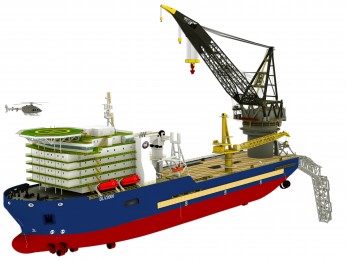In a prominent contract involving two large rescue ships, MAN Diesel & Turbo is to supply two twin-screw complete propulsion packages based on its latest MAN L48/60CR engines, Renk RSHL reduction gears and newly designed Alpha Mk 5 propellers.
 The two new rescue ships are to be built by the CSSC GuangZhou HuangPu Shipbuilding Company Limited, China. At 117 metres overall, and speeds up to 22 knots the newbuildings are to operate for the BeiHai Rescue Bureau and DongHai Rescue Bureau – of the Chinese Ministry of Transport.
The two new rescue ships are to be built by the CSSC GuangZhou HuangPu Shipbuilding Company Limited, China. At 117 metres overall, and speeds up to 22 knots the newbuildings are to operate for the BeiHai Rescue Bureau and DongHai Rescue Bureau – of the Chinese Ministry of Transport.
MAN Diesel & Turbo’s four stroke medium speed engines, of the well-established 48/60CR  (Tier II common rail) family offer 1,200 kW per cylinder at 500 rpm and are here chosen for the twin diesel-mechanical propulsion system. 6 cylinder 48/60CR engines power the RSHL1000 reduction gears from MAN Diesel & Turbo’s sister company and gear specialist Renk AG. The Renk gears also feature shaft alternators driven from 2,400 kW primary PTO’s.
(Tier II common rail) family offer 1,200 kW per cylinder at 500 rpm and are here chosen for the twin diesel-mechanical propulsion system. 6 cylinder 48/60CR engines power the RSHL1000 reduction gears from MAN Diesel & Turbo’s sister company and gear specialist Renk AG. The Renk gears also feature shaft alternators driven from 2,400 kW primary PTO’s.
Completing the power train, are twin four-bladed 4.0 metre diameter Alpha VBS1020 Controllable Pitch Propellers of the new high-efficient Mk 5 design generation. Tail shafts of 20 metre and 3 x 8.5 metre intermediate shafting are specified.
Two Alphatronic 2000 Propulsion Control and Management System (for engine control room, main bridge and aft bridge control stations – are in charge of the propulsion power and speed control.
 Mr. Goetz Kassing, General Manager, MAN Diesel Shanghai Co. Ltd. explains: “The 48/60CR engines have been chosen for these rescue vessel newbuildings due to their wide operational flexibility and their combination of favourable fuel efficiency, low emissions levels and invisible smoke under part-load operation. With flexible control of injection pressure, timing and rate shaping, common rail fuel injection allows emissions and fuel consumption to be optimised over the engine’s entire load range. Combined with the new Mk 5 generation of Alpha CP Propellers, ultimate ship propulsion power and speed flexibilities are offered for the many operating modes and mission tasks of the rescue vessels.”´
Mr. Goetz Kassing, General Manager, MAN Diesel Shanghai Co. Ltd. explains: “The 48/60CR engines have been chosen for these rescue vessel newbuildings due to their wide operational flexibility and their combination of favourable fuel efficiency, low emissions levels and invisible smoke under part-load operation. With flexible control of injection pressure, timing and rate shaping, common rail fuel injection allows emissions and fuel consumption to be optimised over the engine’s entire load range. Combined with the new Mk 5 generation of Alpha CP Propellers, ultimate ship propulsion power and speed flexibilities are offered for the many operating modes and mission tasks of the rescue vessels.”´
